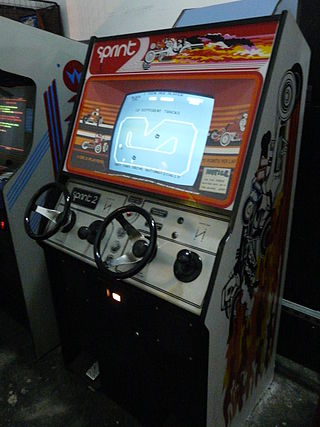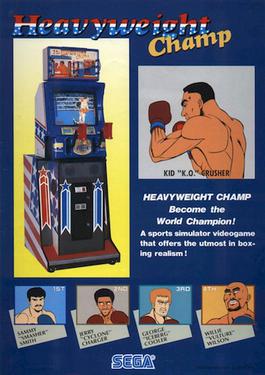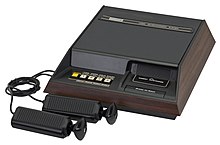
Arkanoid is a 1986 block breaker arcade game developed and published by Taito. In North America, it was published by Romstar. Controlling a paddle-like craft known as the Vaus, the player is tasked with clearing a formation of colorful blocks by deflecting a ball towards it without letting the ball leave the bottom edge of the playfield. Some blocks contain power-ups that have various effects, such as increasing the length of the Vaus, creating several additional balls, or equipping the Vaus with cannons. Other blocks may be indestructible or require multiple hits to break.

Zaxxon is an isometric shooter arcade video game, developed and released by Sega in 1982. The player pilots a ship through heavily defended space fortresses. Japanese electronics company Ikegami Tsushinki also developed the game.
Racing games are a video game genre in which the player participates in a racing competition. They may be based on anything from real-world racing leagues to fantastical settings. They are distributed along a spectrum between more realistic racing simulations and more fantastical arcade-style racing games. Kart racing games emerged in the 1990s as a popular sub-genre of the latter. Racing games may also fall under the category of sports video games.
A sports video game is a video game that simulates the practice of sports. Most sports have been recreated with video games, including team sports, track and field, extreme sports, and combat sports. Some games emphasize playing the sport, whilst others emphasize strategy and sport management. Some, such as Need for Speed, Arch Rivals and Punch-Out!!, satirize the sport for comic effect. This genre has been popular throughout the history of video games and is competitive, just like real-world sports. A number of game series feature the names and characteristics of real teams and players, and are updated annually to reflect real-world changes. The sports genre is one of the oldest genres in gaming history.

Breakout is an arcade video game developed and published by Atari, Inc. and released on May 13, 1976. It was designed by Steve Wozniak, based on conceptualization from Nolan Bushnell and Steve Bristow, who were influenced by the seminal 1972 Atari arcade game Pong. In Breakout, a layer of bricks lines the top third of the screen and the goal is to destroy them all by repeatedly bouncing a ball off a paddle into them. The arcade game was released in Japan by Namco. Breakout was a worldwide commercial success, among the top five highest-grossing arcade video games of 1976 in both the United States and Japan and then among the top three highest-grossing arcade video games of 1977 in the US and Japan. The 1978 Atari VCS port uses color graphics instead of a monochrome screen with colored overlay.
The golden age of arcade video games was the period of rapid growth, technological development, and cultural influence of arcade video games from the late 1970s to the early 1980s. The release of Space Invaders in 1978 led to a wave of shoot-'em-up games such as Galaxian and the vector graphics-based Asteroids in 1979, made possible by new computing technology that had greater power and lower costs. Arcade video games switched from black-and-white to color, with titles such as Frogger and Centipede taking advantage of the visual opportunities of bright palettes.

Tomohiro Nishikado is a Japanese video game developer and engineer. He is the creator of the arcade shoot 'em up game Space Invaders, released to the public in 1978 by the Taito of Japan, often credited as the first shoot 'em up and for beginning the golden age of arcade video games. Prior to Space Invaders, he also designed other earlier Taito arcade games, including the shooting electro-mechanical games Sky Fighter (1971) and Sky Fighter II, the sports video game TV Basketball in 1974, the vertical scrolling racing video game Speed Race in 1974, the multi-directional shooter Western Gun in 1975, and the first-person combat flight simulator Interceptor (1975).

Gun Fight, known as Western Gun in Japan and Europe, is a 1975 multidirectional shooter arcade game designed by Tomohiro Nishikado, and released by Taito in Japan and Europe and by Midway in North America. Based around two Old West cowboys armed with revolvers and squaring off in a duel, it was the first video game to depict human-to-human combat. The Midway version was also the first video game to use a microprocessor instead of TTL. The game's concept was adapted from Sega's 1969 arcade electro-mechanical game Gun Fight.
The following article is a broad timeline of arcade video games.
1977 had sequels such as Super Speed Race and Datsun 280 ZZZAP as well as several new titles such as Space Wars. The year's highest-grossing arcade games were F-1 and Speed Race DX in Japan, and Sea Wolf and Sprint 2 in the United States. The year's best-selling home system was Nintendo's Color TV-Game, which was only sold in Japan.
1975 had new titles such as Western Gun, Dungeon and dnd. The year's best-selling arcade game was Taito's Speed Race, released as Wheels and Wheels II in North America.
1974 had new titles such as Speed Race, Dungeon, Gran Trak 10, Tank and TV Basketball. The year's best-selling arcade game was Tank by Kee Games.

Sprint 2 is a two player overhead-view arcade racing video game released in 1976 by Kee Games, a wholly owned subsidiary of Atari, and distributed by Namco in Japan. While earlier driving games had computer-controlled cars that moved along a "canned predetermined" course, Sprint 2 "introduced the concept of a computer car that had the intelligence to drive itself around the track" in "a semi-intelligent" manner.

Heavyweight Champ is a series of boxing video games from Sega. The original arcade video game was released in 1976. The game uses black-and-white graphics and critics have since identified it as the first video game to feature hand-to-hand fighting. It was a commercial success in Japan, where it was the third highest-grossing arcade video game of 1976.

Sea Wolf is an arcade video game designed by Dave Nutting and released by Midway in 1976. It is a video game update of an electro-mechanical Midway game, Sea Devil, itself based on Sega's 1966 electro-mechanical arcade submarine simulator Periscope. The game was released in Japan by Taito. In Sea Wolf, the player, piloting an unseen submarine, launches torpedoes vertically in an attempt to sink ships moving horizontally across the screen before time runs out. The screen is viewed through a faux periscope mounted on the cabinet.

Road Race is a 1976 car driving arcade racing video game developed and released by Sega in February 1976. Later the same year, Sega released two motorbike racing variants, Man T.T. and Moto-Cross, which were in turn re-branded as Fonz, in November 1976. The game was based on the character Fonzie from the 1970s TV show Happy Days, with the slogan being "TV's hottest name, Your hottest game." Sega licensed Fonz because at the time it was owned by Charles Bluhdorn's Gulf+Western Company and it was a Paramount Television intellectual property.

Speed Race is a 1974 arcade racing video game developed and manufactured by Taito and released under the titles Racer and Wheels in North America by distributor Midway Manufacturing in 1975. Designed by Tomohiro Nishikado, the gameplay involves the player using the attached steering wheel to maneuver a car alongside a fast vertical scrolling road. The objective is to score points by driving past other cars without colliding with them; more points are awarded for driving faster. Players must do this under a 90-second time limit, which ends the game when it runs out. The gameplay concepts were adapted from two earlier driving electro-mechanical games: Kasco's Mini Drive (1958) and Taito's Super Road 7 (1970).
Electro-mechanical games are types of arcade games that operate on a combination of some electronic circuitry and mechanical actions from the player to move items contained within the game's cabinet. Some of these were early light gun games using light-sensitive sensors on targets to register hits, while others were simulation games such as driving games, combat flight simulators and sports games. EM games were popular in amusement arcades from the late 1940s up until the 1970s, serving as alternatives to pinball machines, which had been stigmatized as games of chance during that period. EM games lost popularity in the 1970s, as arcade video games had emerged to replace them in addition to newer pinball machines designed as games of skill.

The 1970s was the first decade in the history of the video game industry. The 1970s saw the development of some of the earliest video games, chiefly in the arcade game industry, but also several for the earliest video game consoles and personal computers.










